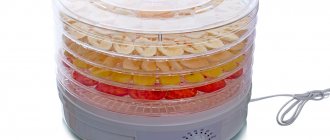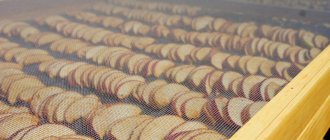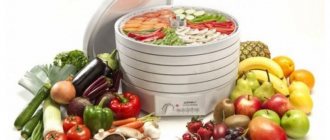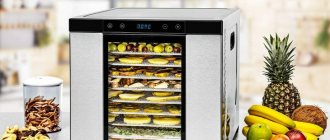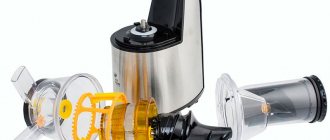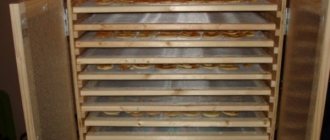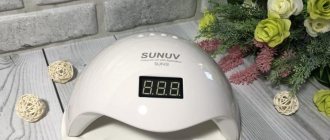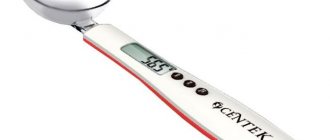For long-term storage of fruits, mushrooms and other products, an infrared dryer for vegetables and fruits is used. It ensures gentle drying, so that at least 95% of all nutrients are retained in products. The moisture is completely separated within several hours at a temperature of 50-70 degrees. Thanks to the presence of a timer, modern dryers automatically turn off after the required time. Therefore, there is no need to control the process - just configure the parameters and go about your business.
Modern models are spacious and multifunctional
How does an infrared dehydrator for vegetables and fruits work?
The operation of the device is based on infrared radiation, which is absorbed by the surface of the product, as a result of which it gradually heats up. Due to a moderate increase in temperature, only water evaporates from the tissues of plants and vegetables, so the device works exactly like a dryer - the radiation does not destroy cellular structures, but only promotes the separation of moisture.
The wavelengths of infrared radiation are in the range between visible red light and microwave radiation, which is used, for example, in microwave ovens. They penetrate deeply into the thickness of the product, even at a distance of several centimeters. As a result, heat loss during processing is no more than 5%. Therefore, the dryer for vegetables and fruits has a very high efficiency and at the same time consumes a minimum amount of electricity.
The device is used for drying various products:
- fruits;
- vegetables;
- berries;
- meat;
- mushrooms;
- roots;
- cheese;
- snacks
Attention! In most cases, modern dryers can operate in several temperature conditions. Some models are also equipped with a function for making marshmallows and yogurt.
Since the main purpose of the device is to evaporate water, it is also called a dehydrator. Depending on the characteristics of the mechanism, there are 2 classes of dryers:
- Mechanical - they are manually controlled by rotary switches, thanks to which the user can set a comfortable temperature.
- Electronic – equipped with a display with touch keys. Allows you to set any temperature with an accuracy of tenths of a degree. They have more convenient functionality - for example, this dehydrator with infrared radiation has the option of automatically turning off the temperature and gradually increasing the heat in accordance with a given program.
By area of application there are:
- Home dryers are convenient low-power devices (usually 250-450 W) that are used for household purposes. You can dry any food in small quantities in them.
- Industrial infrared dryers for vegetables and fruits are used in production. They have several shelves on which they place tens and hundreds of kilograms of raw materials.
Dehydrator Airhot FD-16GR (with rotation) drying cabinet for fruits and vegetables
Article: 05-117-0011 Dimensions: 550x420x740 Country: China Manufacturer: Airhot 16 levels, temperature 40-90°C, with grill rotation, 15h timer, stainless steel, 220V, 1.8 kW, 28kg
General information.
The industrial dehydrator drying cabinet for fruits and vegetables belongs to the class of thermal equipment for catering establishments, food production and trade.
Purpose.
Professional dehydrators and drying cabinets are designed for drying fruits, vegetables, fish in the volumes required for food and trade enterprises.
Peculiarities.
This dehydrator, a drying cabinet for fruits and vegetables, is equipped with powerful heating elements to ensure high performance, and for use in industrial food production conditions, the dehydrator is equipped with a stainless steel housing. Adjustable drying times allow you to produce products with varying degrees of dehydration, and the housing protects the operator from contact with hot heaters.
Pros and cons of infrared dryers
Thanks to the “soft” effect of infrared radiation, dryers have several advantages:
- They remove moisture and at the same time do not destroy beneficial substances (safety of 95%).
- Drying is 2 times faster than in convective devices, in which the process occurs due to hot air blowing.
- Energy consumption is minimal.
- Processed products become sterile, since even at temperatures of 40 degrees and above many microorganisms die.
- Products acquire a natural taste even after long-term storage (for 1-2 seasons).
At the same time, devices may also have some disadvantages. They are mainly related to the features of a particular model. For example, buyers often note that the device has a short power cord or does not allow you to adjust the temperature automatically. However, modern dehydrators do not have these disadvantages.
How to choose an infrared dryer for fruits and vegetables
When choosing a device, it is important to pay attention to several indicators:
- Power - for home purposes, 250-450 W is enough. At the same time, many models develop power up to 500-700 W, which is quite suitable for any volume of raw materials.
- Number of trays - usually the devices are equipped with 4-5 pull-out trays, onto which 3-5 kg can be loaded at a time (up to 25-30 kg in total).
- Control type – preferably electronic rather than mechanical. Thanks to this, the user will be able to adjust the temperature and drying time.
- Overheat protection is a useful feature that automatically turns off the dryer in case of prolonged load.
- Electronic display – its presence allows you to conveniently set the necessary parameters and monitor the progress of the process.
- The noise level can be checked directly in the store. Many modern models operate no louder than a refrigerator; the sound is practically inaudible.
Advice! You shouldn’t choose a dryer based solely on cost, since many budget models are not comfortable or durable. It is better to buy a reliable device that will work effectively for several seasons in a row.
Functionality
If you want to know the answer to the question, which is the best mushroom dryer , you also need to raise the topic regarding the functionality of the device. First of all, you should choose equipment that is suitable not only for drying mushrooms, but also fruits, vegetables and herbs, because then you will be able to use it more often, and it will certainly be useful not only during the mushroom picking period. Some of the dryers on the market come with a timer, which means you can set an exact time for it to run and it will automatically turn off when it's done. Some models also have a digital display that allows you to select settings efficiently. Although it is much simpler, it is also convenient to use regular buttons or knobs. It is only important that they work well and are clearly marked.
Safety
Probably everyone will agree with the statement that safety is key. For this reason, you should check whether the appropriate solutions have been used in the mushroom and berry dryer you have chosen. This includes, among other things, effective overheating protection, which guarantees not only safe, but also trouble-free operation. The dryer should also have a well-balanced base that remains stable throughout the entire operation. It is best if the unit is equipped with non-slip feet or lids to prevent the mushroom dehydrator from sliding around the kitchen counter.
Care
Satisfaction with the use of equipment depends not only on its performance or ease of use, but also on its maintenance. Consumers tend to choose devices that are easy to clean. Some of the dryers on the market are dishwasher safe (individual elements), making it easier to keep them perfectly clean.
Dryers for mushrooms and berries at good prices
How much can you buy the cheapest mushroom dryer for? You will pay less than 3,000 rubles for a model of medium power and not very large capacity. Slightly larger equipment with better parameters is usually more expensive. If you want to buy it, you should be prepared to spend about 4,500 - 6,000 rubles or a little more.
Rating of infrared dehydrators
A review of various models of infrared dryers for vegetables and fruits shows that electronically controlled models are the most popular. They allow you to set the desired temperature and drying duration - for example, 10 hours, after which they turn off automatically.
Gemlux GL-IR500
Judging by the reviews of the infrared dehydrator-dryer Gemlux gl ir500 (more than 170 thousand buyers), this device is very popular - rating 4.8-5.0 points out of 5. The device has sufficient power, a convenient plastic case and reliable metal trays.
Characteristics:
- power 500 W;
- 5 pallets;
- drying temperature from 30 to 70°C;
- temperature adjustment;
- presence of display and electronic control;
- timer.
The principle of operation of home dryers is the same as that of industrial ones, but they differ in power and size
L'EQUIP IR-D5
The infrared dehydrator I equip ir d5, according to various services, is rated 5 points out of 5 by customers. This is a fairly powerful dryer that has the following characteristics:
- volume 23 l;
- 5 metal pallets;
- drying temperature from 35 to 70 degrees;
- power 500 W;
- plastic case;
- electronic control system;
- presence of a timer and display;
- protection against the risk of overheating;
- Possibility of making yoghurt and marshmallows.
A practical and convenient model that has been rated by thousands of users
Samobranka
The domestic infrared dryer for vegetables and fruits Samobranka is well suited for drying a wide variety of products:
- fish;
- meat;
- greenery;
- mushrooms;
- berries;
- flour products;
- leaves and herbs;
- greenery
The device is a mat with a mesh that emits infrared rays. Thanks to its small dimensions (50*75 cm), it consumes a minimum amount of energy of 0.1 kW/h, but at the same time copes well with the main task. Suitable for home use both in the apartment and in the country.
Characteristics:
- power 150 W;
- loading up to 3 kg;
- diameter (collapsed) 12 cm;
- mechanical control.
Many people choose this model for its compactness.
Radio plant Dachnik-4
Another Russian model is the “Dachnik” infrared dryer for vegetables and fruits. Has the following characteristics:
- power 800 W;
- 4 metal pallets;
- metal body;
- mechanical temperature adjustment (manual);
- loading up to 4 kg;
- temperature from 40 to 70°C.
Customer rating – 5 points out of 5.
Volumetric dryer that is suitable for a large family
Kitfort KT-1909
This dehydrator is an infrared dryer that is particularly popular among customers (4.3 out of 5 stars) due to its ease of use and durability.
Characteristics:
- power 700 W;
- temperature from 35 to 70 degrees;
- 9 metal pallets;
- electronic control;
- presence of a display and timer (up to 19.5 hours with an interval of 30 minutes);
- overheat protection system;
- Possibility of making pastilles.
Thanks to the transparent door you can monitor the drying process
Industrial dryer designs
Dryers using the laws of thermodynamics (evaporation of moisture from raw materials) Typically, an industrial dryer is a specialized design that uses the laws of thermodynamics to dry raw materials, which creates an environment with the properties of a coolant for the purpose of removing/supplying heat, and thus drying the processed raw materials. Over the years, drying equipment has been improved many times, and today this process has not stopped. Modern designs are very diverse. The use of specific schemes and individual components is determined by the geometry, chemical and physical properties of the dried raw materials, the type of drying agent, and operating modes. The most widespread are the typical designs of drying installations: – atmospheric; – bellhops; – drums; – chamber; – vacuum; – vacuum-pulse.
A significant disadvantage of this type of dryer is significant energy consumption and low retention of nutrients in the final product.
Special types of dryers
Among the variety of drying units, it is customary to distinguish their special types, which include: – high-frequency; – sublimation; – contact; – convective pneumatic; – infrared.
New generation dryers Kinetic type industrial dryers do not use the laws of thermodynamics and are more economical. The first dryer based on the principle of kinetic knocking out of moisture was the patented Canadian KDS technology for bulk products (works with raw material moisture content up to 65%), our Russian developers of ASKT technology went much further (the technology for drying raw materials up to 90-95%) went much further by combining 6 methods in one dryer dehydration of raw materials, where also one of the methods is the kinetic effect of raw material particles on each other.
So let’s look at the design of industrial dryers in more detail using examples.
Atmospheric convection dryers
Atmospheric drying is carried out in open space or under a canopy. Due to the low ability of air at low temperatures to absorb moisture vapor, this process takes a long time and practically stops in winter. That is why this technology was replaced by a more progressive one - atmospheric convective drying. The principle of its operation is based on loading dried raw materials into a specially equipped chamber, where it remains motionless. Drying is carried out in air or fuel combustion. Significant disadvantages of this method include uneven drying, high labor intensity of loading and unloading operations, and huge heat losses due to the accumulation of enclosing walls. With all this, such equipment has found application in mechanical engineering and metallurgy. However, such a unit will not be suitable as a vegetable dryer, because its use will at least not be profitable.
Corridor dryers
The operating principle of tunnel or corridor dryers is based on the movement of material using transport equipment along a special discharge channel. The drying speed is determined by the frequency of movement of raw materials and the intensity of movement of the drying agent. To increase efficiency, zoning or complete recycling of the working environment is used. Thus, the average temperature and the degree of humidity of the drying agent increase.
The classic design of tunnel dryers consists of several parallel and partially closed channels through which the drying agent and trolleys loaded with material move. The ventilation system is located, as a rule, at the end - at the place where raw materials are loaded. Due to the relatively low mobility of the material and the possibility of delamination in the heated and cold air channels, uneven drying is observed. To eliminate this negative effect, it is best to use tunnels with stepped heating.
Drum dryers
Drum dryers are designed for processing lump-shaped, granular, and bulk materials, such as coal, limestone, clay, sand, and pasty materials. Depending on the method of heat transfer from the drying agent to the raw material, it is customary to distinguish three types of drum dryers: 1. Indirect action - heat is transferred through the walls of the drum. 2. Direct action - the drying agent directly contacts the material. 3. Mixed type - designs that combine the first two methods.
Most of these dryers are an inclined conical or cylindrical drum rotating at a constant speed. Special nozzles are installed inside the structure, which provide intense mixing and thereby speed up drying. During rotation, the blades pick up and lift up part of the processed material, which sequentially flows down or falls in the gas flow. This pouring significantly increases the area of contact of the raw material with the drying agent.
Chamber dryers
Chamber types of dryers are the most common and allow you to process raw materials in any original state. The drying agent is flue gases, heated air, and, somewhat less frequently, superheated water steam. Chamber dryers are structurally a chamber that consists of specialized shelves, movable trolleys, baking trays, and nets where the materials to be dried are located. Such installations are universal, because they allow you to simply organize the recirculation of a specific drying agent, or quickly adjust the mode to a specific raw material. Today there are a huge number of designs of chamber dryers, the principle of operation of which remains the same, only the methods of unloading/loading and the type of circulation of the drying agent differ.
The main disadvantage of such equipment is the huge heat consumption, which is spent on heating the entire structure due to cyclical operation. In addition, drying of any material occurs unevenly on the lower and upper tiers.
High frequency dryers
The principle of operation of such units is to convert alternating current into high-frequency current, supplied to the structure of plate capacitors, between which the processed material is moved using a conveyor belt. The high-frequency electric field promotes the release of heat and drying of the material. By controlling the field strength, the temperature gradient and, consequently, the drying intensity are regulated. For example, this is how vitamin-herbal flour is produced.
Advantages: high-frequency fruit dryer is characterized by high processing speed of raw materials and uniform drying of bulk materials. Disadvantages: high cost of equipment and significant energy costs.
Freeze dryers
In this unit, the drying chamber (sublimator) is equipped with hollow plates through which heated water continuously circulates. The dried raw materials are placed on baking sheets placed on these plates. Heat from the latter is transferred to the material by radiation. The mixture of steam and air from the sublimator passes to the pipes of the freezing condenser, where the process of condensation and freezing of waste water vapor occurs. The use of such technology is relevant when high demands are placed on the dried product regarding the preservation of its properties over a long period of storage. Today, only particularly valuable raw materials that do not tolerate heat drying (for example, a herb dryer) are dried using sublimation.
Advantages: dried products completely retain their own biological qualities over a long period of time. Disadvantages: high cost of technology and operation.
Contact dryers
Contact devices are actively used in conditions where the use of high-performance equipment is not justified. By design, such equipment is a drying chamber in which hollow slabs are located, heated from the inside with water or steam. The processed raw materials are located in trays installed on top of such plates. To improve operating efficiency, contact drying installations are equipped with vacuum creation devices.
Advantages: allowed for drying explosive substances and materials that emit valuable or harmful vapors (for example, manure dryer, droppings, etc.). Disadvantages: relatively low productivity and efficiency due to the immobility of raw materials.
Convective pneumatic dryers
They are also mistakenly called aerodynamic dryers. Used for drying crystalline and grain materials in suspension. The process is carried out in a vertical pipe, the length of which can reach 20m. Particles of material move in a stream of heated air. The raw material is fed from the hopper into the pipe, where it is carried away by the air flow, forced by a powerful fan and heated by a heater. Hot air carries the dried material into a special collection, from where it is removed using a special unloading device. The air after filtration is released into the atmosphere.
Advantages: simplicity of design, compact size. Disadvantages: high energy consumption, area of use is strictly limited, incoming raw material humidity does not exceed 65%
Infrared dryer
The operating principle of an infrared dryer is based on the penetration of IR radiation directly into the material being processed. In this case, the absorption of the spectrum is carried out not by the soft tissues of the raw material, but by the moisture itself. Thus, any product can be rid of excess water without losing any beneficial properties. In addition, if you put processed vegetables in water for a certain time, they can almost completely return to their original form. The drying process is carried out at low temperatures of 40-60 degrees.
Advantages: simplicity of the processing procedure; restoration of shape when soaked in water. Disadvantages: relatively high cost, low retention of nutrients
Principles for choosing an industrial dryer
The selection of the type and design of an industrial dryer depends on the scope of use and on the planned load intensity of such equipment. Thanks to the widest modern assortment, it is quite easy to get confused, which is why when choosing, you should first take into account the following points: 1. Working volume - the ability of the unit to dry a certain amount of raw material in one cycle. 2. Operating principle and type of drying agent. 3. Power consumption per cycle. 4. Productivity. 5. Possibility of improvement and availability of additional options.
How to use it correctly
You should check the dehydrator for vegetables and fruits in the store. After delivery home for the first time, it is recommended to remove the trays (top and bottom) and let them idle for 30-60 minutes. Then you can place the food on the tray. The rules of use are simple:
- Arrange vegetables, fruits, and mushrooms so that there is always a small distance between them.
- Fill the trays in advance; do not cut the fruits, as this will cause the juice to leak out.
- Place similar vegetables and fruits on the same tray so that they are not saturated with foreign odors - for example, you should not put fish and garlic.
- Use trays for their intended purpose - mesh with small cells for herbs, flexible - for berries, tomatoes, bananas, standard trays - for other products.
- When laying out the fruits, do not water them with oil, as this may lead to cracking.
Attention! Water should not come into contact with the emitter - if this happens, you must immediately turn off the dehydrator. Do not place flammable substances, including oil, near the device.
Reviews of infrared dryers
Ekaterina, 35 years old, Yaroslavl
Excellent dryer Kitfort 1909. Stylish and comfortable, the most important thing is that there are no foreign odors, the taste of vegetables and fruits is preserved in their original form, it even seems better than fresh ones. We set all parameters automatically, no problems will arise. We've been using it for 3 years and haven't needed a single repair yet.
Boris, 54 years old, Moscow
I liked the Dachnik vegetable and fruit dryer. Made quite simply. The unit works well and reliably. We have been operating for 2 years, we have no complaints. You can dry any fruits, greens, herbs - of your choice.
Anna, 60 years old, Tula
We bought Samobranka - this is a roll with a mesh. Unwind, place on the table and lay out 2-3 kg of vegetables or fruits. A very simple device - probably the cheapest of this series. Suitable for small volumes.
Anna, 60 years old, Tula
We bought Samobranka - this is a roll with a mesh. Unwind, place on the table and lay out 2-3 kg of vegetables or fruits. A very simple device - probably the cheapest of this series. Suitable for small volumes.
